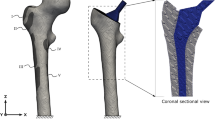A method for personalized analysis of the stress−strain curve of the endo-prosthetics subsystem of an endo-exo prosthetics system implanted into the femoral medullary canal is presented. The method is based on the analysis of CT scans. The results of test application of the method are presented. The goal of the study is to determine the reliability and the strength margin of the implant−bone system under conditions of osseointegration in a walking patient. The study has shown that the bone density is sufficiently high to meet the requirements for the endo-exo femur prosthesis; the strength margin of the bone is 11.5.
Similar content being viewed by others
References
Ziegler-Graham, K. et al., “Estimating the prevalence of limb loss in the United States: 2005 to 2050,” Arch. Phys. Med. Rehab., 89, No. 3, 422-429 (2008).
Thesleff, A. et al., “Biomechanical characterisation of bone-anchored implant systems for amputation limb prostheses: A systematic review,” Ann. Biomed. Eng., 46, No. 3, 377-391 (2018).
Sherman, R. A., “Utilization of prostheses among US veterans with traumatic amputation: A pilot survey,” J. Rehab. Res. Develop., 36, No. 2, 100-108 (1999).
Hagberg, K. and Brånemark, R., “Consequences of nonvascular transfemoral amputation: A survey of quality of life, prosthetic use and problems,” Prosth. Orthot. Int., 25, No. 3, 186-194 (2001).
Legro, M. W. et al., “Issues of importance reported by persons with lower limb amputations and prostheses,” J. Rehab. Res. Develop., 36, No. 3, 155-163 (1999).
Cowin, S. C. and He, Q. C., “Tensile and compressive stress yield criteria for cancellous bone,” J. Biomech., 38, No. 1, 141-144 (2005).
Carpenter, R. D., “Finite element analysis of the hip and spine based on quantitative computed tomography,” Curr. Osteopor. Rep., 11, No. 2, 156-162 (2013).
Wolfram, U. et al., “Fabric-based Tsai-Wu yield criteria for vertebral trabecular bone in stress and strain space,” J. Mech. Behav. Biomed. Mat., 15, 218-228 (2012).
Zysset, P. K. et al., “Finite element analysis for prediction of bone strength,” BoneKEy Reports, 2, 386 (2013).
Hart, N. H. et al., “Mechanical basis of bone strength: Influence of bone material, bone structure and muscle action,” J. Musculoskelet. Neuronal Interact., 17, No. 3, 114 (2017).
Biewener, A. A., “Safety factors in bone strength,” Calcif. Tissue Int., 53, No. 1, 68-74 (1993).
Author information
Authors and Affiliations
Corresponding author
Additional information
Translated from Meditsinskaya Tekhnika, Vol. 56, No. 1, Jan.-Feb., 2022, pp. 28-30.
Rights and permissions
About this article
Cite this article
Sinegub, A.V., Lopota, A.V. & Suvorov, V.A. Personalized Finite Element Analysis of an Endo-Exo Prosthetics System under Conditions of Osseointegration. Biomed Eng 56, 40–43 (2022). https://doi.org/10.1007/s10527-022-10162-x
Received:
Published:
Issue Date:
DOI: https://doi.org/10.1007/s10527-022-10162-x




